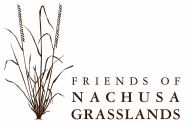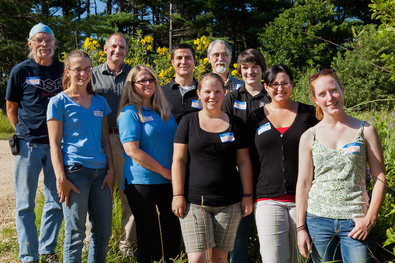2015 Friends of Nachusa Grasslands Scientific Research Grant Awards and Summaries — $15,000
|
Thomas Anton, Michael Dreslik, and David Mauger, Independent researchers — $1,000. This team is undertaking a comprehensive survey of the state endangered Blanding’s Turtle in all of its potential habitats at Nachusa. They will also continue the documentation of species such as the queen snake, ribbon snake, western hognose snake, central newt, glass lizard, and racerunner not documented in their 2013 survey work. This work should inform management of Blanding’s turtles and other turtles at Nachusa.
Elizabeth Bach, PhD., Post–doctoral research fellow, Illinois Natural History Survey — $2,200. Dr. Bach is studying the functional role of prairie soil fungal communities in cycling and storing carbon and nitrogen in prairie ecosystems. Specifically, she proposes to contrast seasonal shifts in prairie fungal communities and fungal–driven C and N cycling in bulk soil and the rhizosphere of cool season and warm season plants. This research should generate a catalog of soil fungal diversity at Nachusa and integrate that information with nutrient turnover and carbon storage. Learning about the timing of microbial turnover of nutrients may lead to new management strategies that could enhance cool season plant competitiveness and overall plant diversity. Nicholas Barber, PhD., Northern Illinois University — $750. With Dr. Barber’s supervision and as part of the Research Rookies Program, this grant will support a beginning student research project on the impact of bison on dung beetle community assembly in restored and remnant tallgrass prairies. The underappreciated dung beetles play an important role in recycling nutrients in prairie ecosystems. The objectives of this project are to document the diversity of dung beetles in restored and remnant prairies, determine how the dung beetle communities change over time following restoration, and determine if bison impact this component of insect biodiversity. Julia Brockman, Master’s degree graduate student, Southern Illinois University — $2,000. Ms. Brockman is studying bison habitat selection and their avoidance of humans at Nachusa. She is collecting hourly GPS location data from collars on seven bison cows and overlaying that data on maps of remnant and restored plant communities and locations of human activity. She will also collect data on bison behavior at different locations and times of day. These observations should help managers develop strategies to optimally plan human/bison interaction, restoration goals, and burn schedules. Bethanne Bruninga–Socolar, PhD graduate student, Rutgers University — $2,000. The aim of this project is to investigate how species and populations of bees, the most important pollinators in tallgrass prairie, respond to prairie restoration. Bee communities collected in prairie restorations of varying ages (1-25 years), remnant prairies, and agricultural areas will be compared with each other. Comparisons will be also be made between areas with and without bison. In addition to suggesting pollinator–friendly management strategies, this project will provide Nachusa with baseline data on bee populations on the preserve. |
Angela Burke, Master’s degree graduate student, Northern Illinois University — $1,200. This project will attempt to quantify how changes in fire intervals and the presence or absence of bison affect small mammal populations in restored and remnant prairie. Ms. Burke will use live capture–mark–recapture methods to measure small mammal diversity, abundance, and seasonal fluctuations in matched pairs of differently aged restoration sites and in remnant sites varying in bison presence/absence and fire frequency.
Heather Herakovich, Master's degree graduate student, Northern Illinois University — $1,500. This is the second year of a study of grassland bird density in 11 plots of land that range from 1–year post restoration to 26–years post restoration as well as remnant control prairies and agricultural field controls. Specifically, the researcher and her trained volunteers are measuring nest density and survivorship by marking each nest found, recording the number of eggs, calculating depredation rates, and determining survivorship of all marked nests. This will provide pre– and post–bison data on grassland bird density in both remnant and restoration sites. Sarah Smith, Master’s degree graduate student, Northern Illinois University — $950. This project will use both field and laboratory methods to analyze dynamic soil properties (aggregate stability, color, structure, carbon content, organic matter content, bulk density) and particle size across a wide range of differently aged and variable topographic restorations in order to study how soils in restorations change over time. When compared to remnant soils and cultivated field soils, this study should provide insight into how effectively and on what time scale restorations effectively reestablish original, prairie–like soils. Pati Vitt, PhD., Chicago Botanic Garden — $1,600. This is a continuing study of Prairie Bush Clover (Lespedeza leptostachya). The specific goal is to determine the effects of litter cover and burning on the germination, growth rate, and seed production of this threatened species. It is hoped that the research may be able to identify new preserve locations where the species can be successfully reintroduced and suggest management guidelines for burning and timing of these new plantings. Mark J. Wetzel, M.S., Illinois Natural History Survey, and John W. Reynolds, PhD., Oligochaetology Lab, Kitchener, Ontario — $1,800. These researchers will sample at least 40-50 sites spread across a wide range of habitats at Nachusa in order to provide accurate species level identifications of the earthworms found at the preserve. Earthworms play an integral role in soil development and health. This project will provide Nachusa with baseline data on both native and introduced species of earthworms on the preserve, and it may suggest native earthworm–friendly management strategies that could in turn enhance soil ecosystem development in restorations. |

